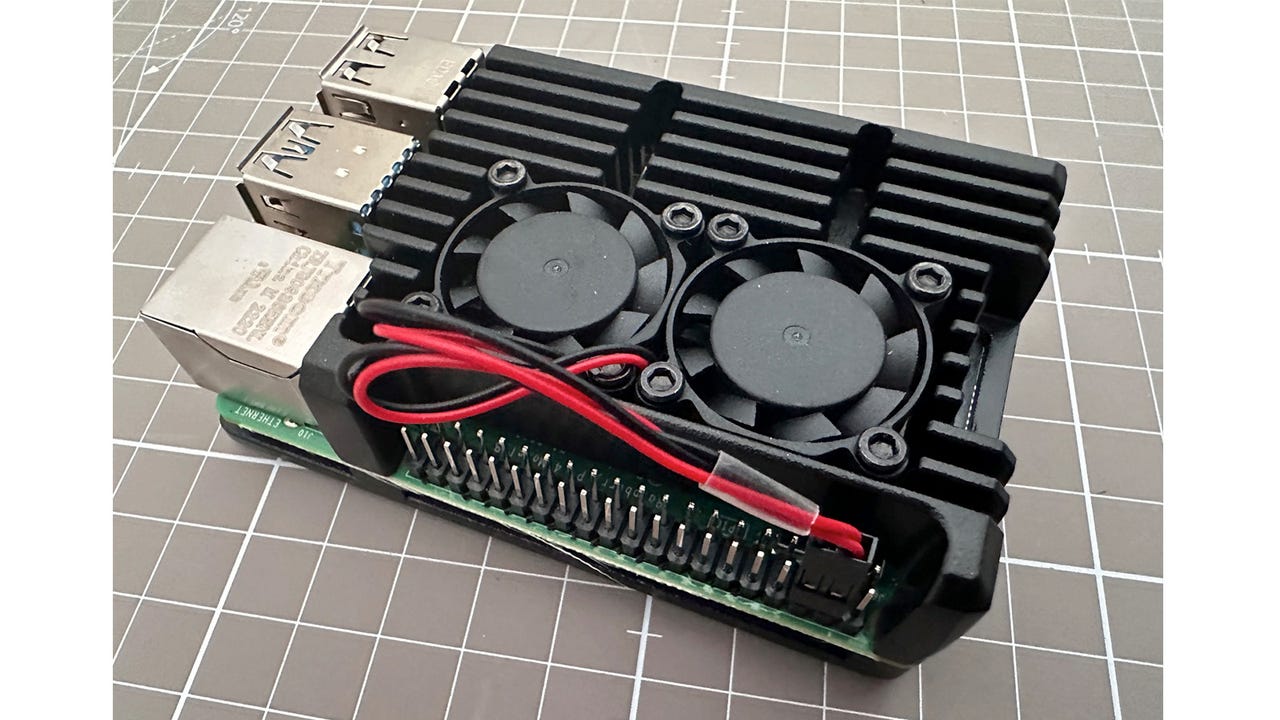
































Raspberry Pi fitted with cooling case.
Adrian Kingsley-Hughes/I love my Raspberry Pi computers and use them whenever and wherever I can.But I can remember that first time I unpackaged a Raspberry Pi board and had to set it up. It was a bit daunting.
But it doesn't have to be.
Also: These are my 3 must-have Raspberry Pi accessories
Here's everything you need to know to set up your first Raspberry Pi
You don't need much. Of course, you need aRaspberry Pi (andkeyboard/mouse /display ), amicroSD card , the operating system you're going to run on the Raspberry Pi, and software to prepare the microSD card and copy the software over to it.
Oh, and if your computer doesn't have a slot for an SD/microSD card, you'll needan adapter .
The software we're going to use to get the microSD card ready for use is the Raspberry Pi Imager.
Why? Because it takes the stress out of everything.
You don't even have to download the operating system you're going to run on your Raspberry Pi -- it'll do that for you!
Also: How I solved one of my biggest Raspberry Pi headaches
You can download the Raspberry Pi Imager here. There are versions for Windows, Mac, and Linux.
Download and install the Raspberry Pi Imager on the computer you want to use to prepare the microSD card.
Right, you now have everything you need. Connect the microSD card to your computer and fire up the Raspberry Pi Imager.
Raspberry Pi Imager software
Adrian Kingsley-Hughes/Now click on Choose OS.
Choose your OS
Adrian Kingsley-Hughes/The default is Raspberry Pi OS (32-bit) which is a good choice, but if you have a Raspberry Pi 3, 4, or 400, you can go find the 64-bit version. To do this, click on Raspberry Pi OS (other) and then scroll down to findRaspberry Pi OS (64-bit)and click on this to select it.
Choose the Raspberry Pi OS (64-bit)
Adrian Kingsley-Hughes/Next, click Choose Storage and click on your microSD card.
Choose your microSD card
Adrian Kingsley-Hughes/I'm a big believer in making things as easy as possible for myself. One way to do this is to use the Raspberry Pi Imager to set the Wi-Fi SSDI (the name of the Wi-Fi network you want it to connect to) and password for me in the Raspberry Pi operating system.
Also: Raspberry Pi: Where to buy the hard-to-find latest model and its alternatives
To do this, click on the cog in the bottom-right of the imager to access theAdvanced Options.
Accessing Advanced Options
Adrian Kingsley-Hughes/Here you'll find a bunch of options.
Scroll down toConfigure wireless LAN, check the box, fill in the details, and clickSave.
Configure wireless LAN
Adrian Kingsley-Hughes/You're now ready to write to the microSD card. ClickWriteto kick off the process.
Write the operating system to the microSD card
Adrian Kingsley-Hughes/You'll be asked if you want to erase everything on the microSD card. ClickYesif you're sure this is the right card.
Confirm erasing the microSD card
Adrian Kingsley-Hughes/Let the writing process commence!
Writing to the microSD card
Adrian Kingsley-Hughes/The software will tell you when it's done. ClickContinueto finish.
Done!
Adrian Kingsley-Hughes/Remove the microSD card from your computer and install it into the Raspberry Pi.
The microSD card fits into the microSD card slot on the underside of the Raspberry Pi. The image below shows the way the card fits into the slot.
The microSD card slot is on the underside of the Raspberry Pi
Adrian Kingsley-Hughes/Slide the card as far into the slot as it will go. There isn't a click or anything to tell you when it's all the way unlike most microSD card slots found on smartphones and drones.
microSD card fully inserted into the slot on the Raspberry Pi
Adrian Kingsley-Hughes/Finally, you need to connect a display and power.
If you're going to be connecting your Raspberry Pi to a TV of computer monitor, then you can use HDMI.
There are two micro HDMI ports built into the Raspberry Pi 4.
The Raspberry Pi 4 Model B has two micro HDMI ports
Adrian Kingsley-Hughes/Since most computer monitors and TVs have a full-sized HDMI port, the best solution here is to get yourself amicro HDMI to HDMI cable.
A micro HDMI to HDMI cable
Adrian Kingsley-Hughes/The micro end connects to one of the micro HDMI ports on the Raspberry Pi, the other end to your TV or monitor.
The micro HDMI connector attached to the micro HDMI port on the Raspberry Pi
Adrian Kingsley-Hughes/Alternatively, you might want to use a touchscreen display on your Raspberry Pi. This is a bit more involved, but it's a fun project that I've detailed here.
Finally, connect your Raspberry Pi to power to boot it up, and you're ready to start your adventure!
You need a USB-C cable to supply power, and you can use a power supply or a power bank to power your Raspberry Pi. I recommend using theofficial USB-C power supply because they are cheap, well made, and super reliable.
Power connects to the USB-C port markedPOWER IN, which is next to the HDMI ports.
Power is supplied to the USB-C port marked POWER IN
Adrian Kingsley-Hughes/There's no on button, so as soon as you connect power to the Raspberry Pi, it'll switch on and start booting up.
Once booted up, the Raspberry Pi will guide you through connecting your keyboard and mouse (it usually involves pressing the pairing button in your keyboard or mouse and waiting a few seconds).
Boot up!
Adrian Kingsley-Hughes/You're done! Enjoy your Raspberry Pi!
 Tags chauds:
informatique
Tags chauds:
informatique